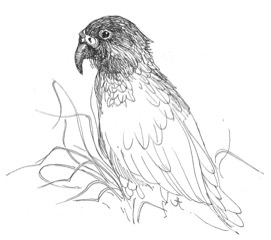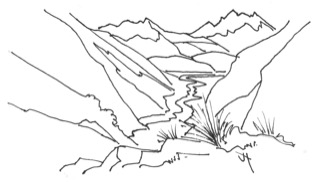
According to OSPRI, the organisation responsible for controlling bovine Tb, 10 years of research have demonstrated “that 1080 can be used to control pests without harming native birds” (Media release, 1/8/23).
OSPRI was bolstering support for its long-standing, industrial-scale poisoning “across millions of hectares of remote bush around the country,” to kill possums (which OSPRI accuses of giving Tb to livestock).
As usual, OSPRI’s claims and aims don’t fit with the research.
“10-year study”
The “10-year study” was largely a mix of MSc and PhD projects at Victoria University. For each student, a 1080 poison project was just one part of their research.
The students’ projects were on birds and invertebrates, mostly in native forests in the lower North Island, which were being poisoned by OSPRI. These animals were likely to eat the poisonous food baits, as well as being at risk as the poison spread into the surrounding area and up food chains.
Sadly, how, where and when the projects were carried out all held them back. Ultimately they failed to shed much light on the effects of poisoning.
Setback 1: How poisoning was studied
Three of the projects studied birds, using automated sound recordings. There was enormous potential to learn from this what went on among birds after poisoning.
But the recorded sound was used just to document whether or not a type of bird was heard. Finding a bird in a sound sample after poisoning meant very little. The students noted that survivors might call a lot, e.g. for missing mates or family, or sorting out new territories, or they might call more because the rats had gone. In fact, students Asher Cook (2017) and Roald Bomans (2018) both found a bird species whose individuals seemed to have increased their calling in the weeks after poisoning.
Nyree Fea’s (2018) bird studies encompassed many months after poisoning. Again, nothing much could be deduced from her simple call/no call data. She noted that an increase in individual calling could result from a growing predator population thinning out the birds.
So – bird calls were still heard after poisoning, but that was not evidence that all was well.

Setback 2: Where poisoning was studied
Even before the tragedy of how data was collected, were the places chosen to research the effects of poison. They had mostly been poisoned before, even the “unpoisoned” experimental control areas, making an effective evaluation impossible. For instance, previous poisonings might have culled out vulnerable species, and were likely to have left the areas grappling with invasive, fast-breeding animals.
Failure 3: When poisoning was studied
No student studied immediately before and after poisoning, the time when an effect would be most expected. The bird records weren’t looked at by Cook until 7 days after poisoning, Bomans waited 1-2 weeks and Fea waited 1.5 years.
Invertebrate studies by Olive Vergara Parra (2018) didn’t start until November, after poisoning in August. She commented that earlier studies would have been better if looking for negative effects, “For example, monitoring detritivore abundance weeks before and weeks after the application of aerial 1080.”
Limited sampling
In addition to the above problems, the research was only at student project level. There was little chance of doing enough sampling to isolate effects of poisoning on the presence of animals, given the number of strong influences on their whereabouts such as vegetation, aspect, altitude, weather, time of day and season.
Rats
As if there wasn’t enough for the students to cope with, rat numbers rose to very high levels during the studies, described by Vergara Parra (2018): “reaching over 90% tracking rate in the Remutaka by July 2015. In the Aorangi … tracking rates were back to pre-1080 level six months after 1080 operation”.
Fea (2018) suggested that the particularly high rat numbers seen in the Remutaka Forest might have been due to the combined effects of the poisoning (which had left resources for the fast-breeding rats to exploit) and masting vegetation (which had also provided abundant food).
Results
The graphs of the students’ bird call and invertebrate measurements were highly variable: some things seemed to have increased, some decreased, some stayed the same and some were all over the place.
The students did find that the rat plagues negatively impacted on some types of birds (Fea, 2018) and invertebrates (Vergara Parra, 2018; Thomas Hewitt, 2021). Discussing her finding that “ground weta suffered negative effects from mesopredator release of rats after a decrease in possums by aerial 1080 application in Aorangi Forest”, Vergara Parra (2018) gently pointed out that 1080 spreading had been associated with boom and bust cycles in rats and mice which may be more harmful to native species than leaving the forests alone.
Overall
In summary, the students’ research was pilot-trial level. Attempts to monitor poisoning effects were stymied by sub-standard methods. Highly variable and concerning results were found. OSPRI has done itself little credit in using these results to promote its mass poisoning programme.


I can add OSPRI and DOC are guilty of selectively using “science” which supports their policies. That “science” is paid, commissioned science, tantamount to Monsanto paying a scientist to come up with the view, Roundup is totally harmless.
Jack, you’ve raised the question as to the integrity of the “paid “science.
In 2007 two retired US scientists Quinn and Pat Whiting-O’Keefe, originally from Stanford Research Institute and University of California, with a considerable knowledge in chemistry and an expertise in statistical inference in complex systems” appeared before an ERMA government review of 1080. They had spent eight months analysing pro-1080 studies.
In the “NZ Herald” the pair stated “There is now a familiar litany of scientifically insupportable claims about what great things aerial 1080, a universal poison, is doing for our forest ecosystems. The people of New Zealand have a right to know the truth about what the scientific evidence shows.”
The pair audited Department of Conservation scientific research and produced an 88-page monograph reviewing more than 100 scientific papers.
“The results are startling and belie most of the department’s claims. First, there is no credible scientific evidence showing that any species of native bird benefits from the dropping of tonnes of 1080 into our forest ecosystems, as claimed by the department —-there is certainly no evidence of net ecosystem benefit.”
Full marks to Dr. Jo Pollard.
Yes 1080 baits are dyed green so birds won’t be attracted to
them, eh???
Maybe that’s why I have photo’s of native birds ( Bush robins ) with green 1080 bait in their beaks!!!!! ( they’re not swallowing tho’ !!! )
AND: I WONDER WHY KEA ARE NOW ON THE ” ENDANGERED SPECIES” LIST???? Too many windscreen wiper rubbers or door seals??? They wouldn’t eat
lovely green, cereal with glucose & cinnamon flavours, eh???? Naaah- that’s all a conspiracy theory. Silly me.
Anyone who doubts that 1080 poison ( a very toxic insecticide) doesn’t kill everything that injests it only needs to go into an area of native bush within a few days of an aerial 1080 drop. It is like a morgue, no birds,no insects & in the summer NO FLIES!!!!!
Many years ago I went tramping in late summer up the Shin River, which flows into the Awatere Valley in Marlborough. There were coveys of quail and chukor numbering hundreds of birds.
A companion and I returned during the Bird Season with spaniels and shot guns anticipating good sport.
There was not a quail or a chukor to be found.
In the interval 1080 had been dropped after baiting.
With the coming election, we have a chance to change this unbelievably bad situation. Like the old saying, ‘if the lies are told long enough, they become the ‘truth’.
There used to be large numbers of Kea along the Milford road but these days you’ll be lucky to see any after a series of 1080 drops right up to the road edge in places. DoC won’t be happy till they are all gone & then wonder why they have perished. I actually saw a mature one on the Kepler track close to Te Anau a month ago but a sighting like that is very rare. Poison has been dropped close to there a few times which has virtually wiped them out locally. The Kea Conservation Trust has studied Kea in the Wapiti area over recent years & were surprised at the large number of birds there, probably the largest population of Kea in the country. No 1080 has ever been used there, I rest my case!
1080 will be to the forefront when I vote next month!